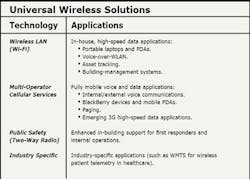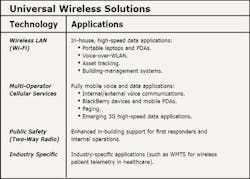Flexible, In-Building Infrastructures
Who has a cellular phone? A wireless-enabled laptop? A BlackBerry or PDA? More importantly, who doesn’t? Just as wireless users, applications, and devices continue to increase in the workplace, so do the expectations for in-building coverage and service availability. And, as most every facilities professional knows, high-frequency radio waves do not propagate well through most building materials, resulting in lost signals.
As a result, according to MobileAccess Networks (www.mobileaccess.com), a Vienna, VA-based developer of in-building wireless solutions, enterprises moving their communications and application roadmap to a wireless platform are turning to flexible, in-building infrastructures that can support a wide assortment of wireless offerings - with a goal to ensure that the wireless coverage is as reliable inside their facilities as outside.
In the past, carriers used the brute-force approach of deploying their own separate infrastructures to provide in-building coverage, resulting in multiple antennas installed in every coverage zone. This redundancy causes interference that can degrade service performance; it also makes it costly to add or upgrade services since additional parallel infrastructures are required.
Another approach, based on radiating coaxial cables, can carry multiple wireless services, but does not scale well due to the significant signal attenuation that occurs at the various service frequencies (cellular, PCS, and Wi-Fi networks). Because the coaxial solution is a single backbone that carries all services, any change made to one section of the building may impact system performance in the entire building.
However, Cathy Zatloukal, president and CEO at MobileAccess Networks, points to overcoming these high costs and infrastructure limitations with a modular, open, hybrid, fiber-coax solution that supports multiple carrier services using a single common cabling infrastructure. Such a technology-agnostic, modular infrastructure ensures that multiple current and future services can be added without additional wiring. “With an enterprise platform, the movement of information goes well beyond a cellular mentality (voice and data only) to such applications as building intelligence, patient monitoring in healthcare applications, etc.,” she says. “[The result is] an infrastructure solution that has a similar look and feel to [that created by] the enterprise IT and telecomm organizations. Essentially, it’s a way to future-proof your investment.”
Obviously, the long-term implications for facilities professionals - and organizations - are significant. Rather than investing in an infrastructure that solves a singular or small set of solutions today, a flexible enterprise system can evolve over time as needs arise and building occupants change. Building owners, as well as operators of public venues such as hotels and convention centers, can also create new revenue streams by providing the value-added service of “anytime, anywhere” connectivity for tenants and visitors, and avoid the challenges of low-quality signals, dropped connections, or the lack of coverage currently faced by many users in large buildings. Additionally, says Zatloukal, such a flexible infrastructure enables quality feedback (a type of feature that the legacy cellular systems can’t easily provide) “so that the enterprise can know for a fact that this network is operational throughout the building.”
Linda K. Monroe ([email protected]) is editorial director at Buildings magazine.

